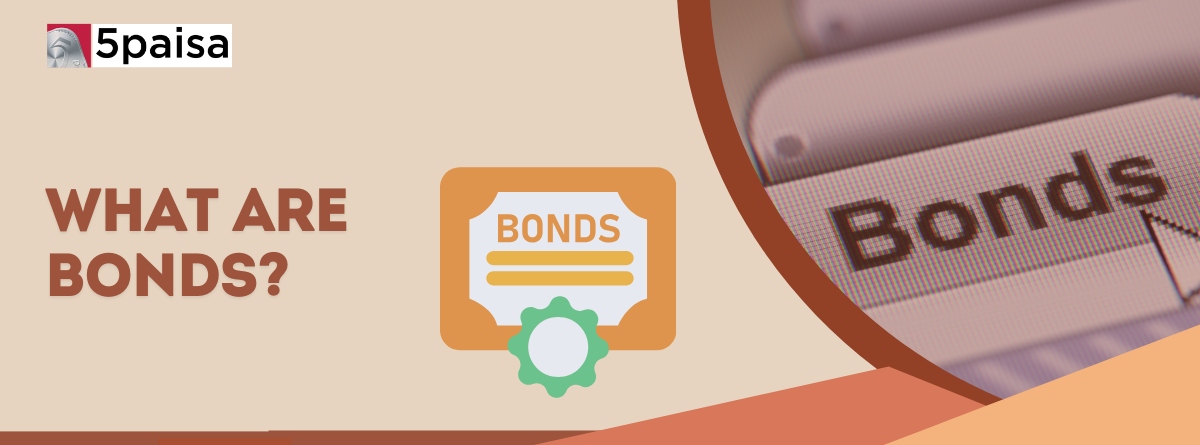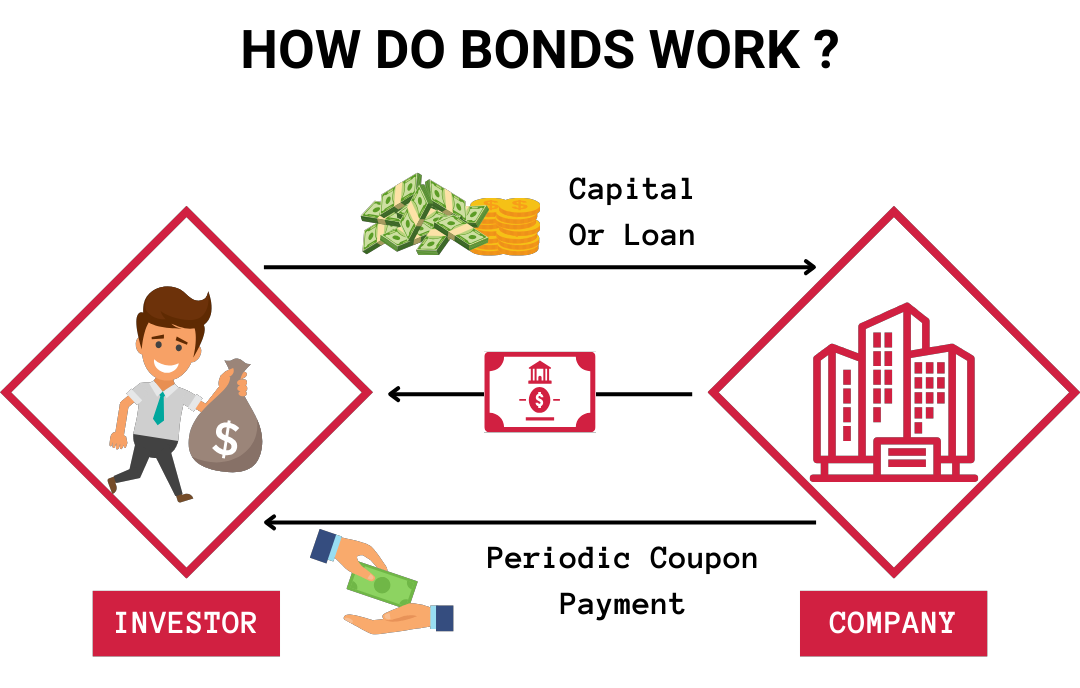What are Bonds?
5paisa Research Team
Last Updated: 15 Oct, 2024 06:05 PM IST

Content
- What Is a Bond?
- Types of bonds
- How do bonds work?
- How To Invest in Bonds?
- Bond Elements
- Example of How Bonds Work
- How Do Bond Ratings Work?
- How Bonds Are Priced?
- Features of a Bond
- Conclusion
A bond is a type of debt security. Bonds are issued by borrowers to attract capital from investors ready to extend a loan to them for a specific period of time.
When you purchase a bond, you are making a loan to the issuer, which could be a corporate, government, or municipality. In exchange, the issuer agrees to pay you a specific rate of interest throughout the course of the bond's existence and to refund the bond's principal when it "matures," or becomes due, after a predetermined amount of time.
Learn more about what is a bond, its types, and more, in this blog.

More About Stock / Share Market
- Sector Rotation Strategy: Meaning, Benefits, and How It Works
- Covered Calls & Covered Puts Explained – Strategies for Income & Risk Management
- Short Covering vs. Short Squeeze: How to Identify Early Signs
- Treynor Ratio: What It Is, Formula & How to Calculate It
- What is Volatility & How to Deal with It?
- What is Sector Rotation? Strategies, Benefits & Limitations
- What is Short Build Up in the Stock Market? Meaning & Impact
- What is GIFT Nifty?
- What is share/stock price?
- What is Gap Up and Gap Down in Stock Market Trading?
- ESG Rating or Score - Meaning and Overview
- What Is Tick Trading? Strategies, Benefits & Risks
- What is Dabba Trading?
- Learn about Sovereign Wealth Fund(SWF)
- Convertible Debentures: A Comprehensive Guide
- CCPS-Compulsory Convertible Preference Shares : Overview
- Order Book and Trade Book: Meaning & Difference
- Tracking Stock: Overview
- Variable Cost
- Fixed Cost
- Green Portfolio
- Spot Market
- QIP (Qualified Institutional Placement)
- Social Stock Exchange(SSE)
- Financial Statements: A Guide for Investors
- Good Till Cancelled
- Emerging Markets Economy
- Difference Between Stock and Share
- Stock Appreciation Rights(SAR)
- Fundamental Analysis in Stocks
- Growth Stocks
- Difference Between ROCE and ROE
- Markеt Mood Index
- Introduction to Fiduciary
- Guerrilla Trading
- E mini Futures
- Contrarian Investing
- What is PEG Ratio
- How to Buy Unlisted Shares?
- Stock Trading
- Clientele Effect
- Fractional Shares
- Cash Dividends
- Liquidating Dividend
- Stock Dividend
- Scrip Dividend
- Property Dividend
- What is a Brokerage Account?
- What is Sub broker?
- How To Become A Sub Broker?
- What is Broking Firm
- What is Support and Resistance in the Stock Market?
- What is DMA in Stock Market?
- Angel Investors
- Sideways Market
- Committee on Uniform Securities Identification Procedures (CUSIP)
- Bottom Line vs Top Line Growth
- Price-to-Book (PB) Ratio
- What is Stock Margin?
- What is NIFTY?
- What is GTT Order (Good Till Triggered)?
- Mandate Amount
- Bond Market
- Market Order vs Limit Order
- Common Stock vs Preferred Stock
- Difference Between Stocks and Bonds
- Difference Between Bonus Share and Stock Split
- What is Nasdaq?
- What is EV EBITDA?
- What is Dow Jones?
- Foreign Exchange Market
- Advance Decline Ratio (ADR)
- F&O Ban
- What are Upper Circuit and Lower Circuit in Share Market
- Over the Counter Market (OTC)
- Cyclical Stock
- Forfeited Shares
- Sweat Equity
- Pivot Points: Meaning, Significance, Uses & Calculation
- SEBI-Registered Investment Advisor
- Pledging of Shares
- Value Investing
- Diluted EPS
- Max Pain
- Outstanding Shares
- What are Long and Short Positions?
- Joint-Stock Company
- What are Common Stocks?
- What is Venture Capital?
- Golden Rules of Accounting: Explained with Examples
- Primary Market and Secondary Market
- What Is ADR in Stock Market?
- What Is Hedging?
- What are Asset Classes?
- Value Stocks
- Cash Conversion Cycle
- What Is Operating Profit?
- Global Depository Receipts (GDR)
- Block Deal
- What Is Bear Market?
- How to Transfer PF Online?
- Floating Interest Rate
- Debt Market
- Risk Management in stock Market
- PMS Minimum Investment
- Discounted Cash Flow
- Liquidity Trap
- Blue Chip Stocks: Meaning & Features
- Types of Dividend
- What is Stock Market Index?
- What is Retirement Planning?
- What is a Stockbroker?
- What is the Equity Market?
- What is CPR in Trading?
- Technical Analysis of Financial Markets
- Discount Broker
- CE and PE in the Stock Market
- After Market Order
- How to earn ₹1000 per day from the stock market
- Preference Shares
- Share Capital
- Earnings Per Share
- Qualified Institutional Buyers (QIBs)
- What Is the Delisting of Share?
- What Is The ABCD Pattern?
- What is a Contract Note?
- What Are the Types of Investment Banking?
- What are Illiquid stocks?
- What are Perpetual Bonds?
- What is a Deemed Prospectus?
- What is a Freak Trade?
- What is Margin Money?
- What is the Cost of Carry?
- What Are T2T Stocks?
- How to Calculate the Intrinsic Value of a Stock?
- How to Invest in the US Stock Market From India?
- What are NIFTY BeES in India?
- What is Cash Reserve Ratio (CRR)?
- What is Ratio Analysis?
- Preference Shares
- Dividend Yield
- What is Stop Loss in the share market?
- What is an Ex-Dividend Date?
- What is Shorting?
- What is an interim dividend?
- What is Earnings Per Share (EPS)?
- Portfolio Management
- What Is Short Straddle?
- The Intrinsic Value of Shares
- What is Market Capitalization?
- What is ESOP? Features, Benefits & How Do ESOPs Work.
- What is Debt to Equity Ratio?
- What is a stock exchange?
- Capital Markets
- What is EBITDA?
- What is Share Market?
- What is an investment?
- What are Bonds?
- What Is a Budget?
- Portfolio
- Learn How To Calculate The Exponential Moving Average (EMA)
- What is India VIX
- The Fundamentals of the Volume in Stock Market
- Offer for Sale (OFS)
- Short Covering Explained
- Efficient Market Hypothesis (EMH): Definition, Forms & Importance
- What Is Sunk Cost: Meaning, Definition, and Examples
- What Is Revenue Expenditure? All You Need To Know
- What are operating expenses?
- Return On Equity (ROE)
- What is FII and DII?
- What is Consumer Price Index (CPI)?
- Blue Chip Companies
- Bad Banks And How They Function.
- The Essence Of Financial Instruments
- How to Calculate Dividend per Share?
- Double Top Pattern
- Double Bottom Pattern
- What is the Buyback of Shares?
- Trend Analysis
- Stock Split
- Right Issue of Shares
- How To Calculate the Valuation of a Company
- Difference between NSE and BSE
- Learn How to Invest in Share Market Online
- How to Select Stocks for Investing
- Do’s and Don’ts of Stock Market Investing for Beginners
- What is Secondary Market?
- What is Disinvestment?
- How to Become Rich in Stock Market
- 6 Tips to Increase your CIBIL Score and Become Loan-worthy
- 7 Top Credit Rating Agencies in India
- Stock Market Crashes In India
- 5 Best Trading Books
- What Is the Taper Tantrum?
- Tax Basics: Section 24 Of The Income Tax Act
- 9 Read-worthy Share Market Books for Novice Investors
- What is Book Value Per Share
- Stop Loss Trigger Price
- Wealth Builder Guide: Difference Between Savings And Investment
- What is Book Value Per Share
- Top Stock Market Investors In India
- Low Price Shares to Invest
- How Can I Invest in ETF in India?
- What is ETFs in Stocks?
- Investment Strategies in Stock Market for Beginners
- How To Analyse Stocks
- Stock Market Basics: How Share Market Works In India
- Bull Market Vs Bear Market
- Treasury Shares: The Secrets Behind The Big Buybacks
- Minimum Investment In Share Market
- What is Delisting of Shares
- Ace Day Trading With Candlestick Charts - Simple Strategy, High Returns
- How Share Price Increase or Decrease
- How to Pick Stocks in Stock Market?
- Ace Intraday Trading With Seven Backtested Tips
- Are You A Growth Investor? Check These Tips to Increase Your Profits
- What Can You Learn From The Warren Buffet Style of Trading
- Value or Growth - Which Investment Style Can be the Best For You?
- Find Why Momentum Investing is Trending Nowadays
- Use Investment Quotes to Improve Your Investment Strategy
- What is Dollar Cost Averaging
- Fundamental Analysis vs Technical Analysis
- Sovereign Gold Bonds
- A Comprehensive Guide To Learn How to Invest In Nifty In India
- What is IOC in Share Market
- Know All About Stop Limit Orders And Use Them To Your Benefit
- What is Scalp Trading?
- What is Paper Trading?
- Difference Between Shares and Debentures
- What is LTP in the Share Market?
- What is Face Value of Share?
- What is PE Ratio?
- What is Primary Market?
- Understanding the Difference between Equity and Preference Shares
- Share Market Basics
- How to Select Stocks for Intraday?
- What is Intraday Trading?
- How Share Market Works In India?
- What are Multibagger Stocks?
- What are Equities?
- What is a Bracket Order?
- What Are Large Cap Stocks?
- A Kickstarter Course: How To Invest In Share Market
- What are Penny Stocks?
- What are Shares?
- What Are Midcap Stocks?
- Beginner's Guide: How to Invest in the Share Market Successfully Read More
Disclaimer: Investment in securities market are subject to market risks, read all the related documents carefully before investing. For detailed disclaimer please Click here.
Frequently Asked Questions
Throughout its term, bonds earn fixed or variable interest rates that are paid to creditors on a regular basis. Because interest is traditionally paid on paper bonds in the form of coupons, bond interest rates are also known as coupon rates. Bond interest rates are determined by a number of factors, including bond duration and the issuer's standing in the public debt market.
Credit rating firms such as Standard and Poor's, Moody's, and Fitch Ratings provide credit ratings for a company and its bonds. The term "investment grade" refers to the highest caliber bonds, which include those issued by the US government and extremely reliable businesses like several utilities.
"High yield" or "junk" bonds are those that are not investment grade but are also not in default. Investors demand a larger coupon payment on these bonds since they have a bigger default risk in the future.
Anyone who is interested in stable and predictable income and little above the fixed deposited return can make investment in the Bonds.
Government and Municipal bond are considering to be safest bond in India.
Yes, you can make profit from Bonds Investment if you stay holder till it matures.
Yes, the issuer and the Credit rating of the bonds and the market situation ans also the bond is embedded or not.



